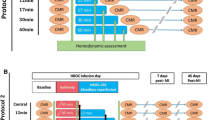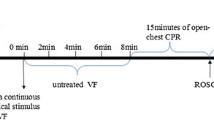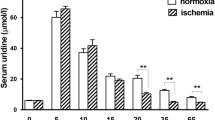Summary
This study was designed to investigate the effects of nicorandil in comparison to isosorbide dinitrate (ISDN) on hemodynamics, on myocardial metabolism and on effectiveness in the preservation of ischemically stressed myocardium.
Repeated ischemia (3 min) was produced in anaesthetized open-chest mongrel dogs by proximal, intermittent left anterior descending artery occlusion with subsequent reperfusion. In each experiment 2–3 control occlusions were compared to 2–3 occlusions under nicorandil or ISDN. Application of both nicorandil (0.64 μmol·kg−1 body weight, i.v.) and ISDN (1.27 μmol·kg−1 body weight, i.v.) led to a significant afterload reduction and to a decrease of the coronary vascular resistance. The efficiency of the compounds in the protection of ischemic myocardium was examined by quantification of oxygen-debt and oxygen-repayment in the occlusion and reperfusion periods. Compared to control, premedication with nicorandil led to a significant increase of oxygen-debt, whereas ISDN reduced it significantly. Oxygen-repayment remained unchanged. The influence of the drugs on the metabolism of glucose, lactate and free fatty acids (FFA) was examined under basic conditions, in ischemia and during reperfusion. For all substrates, extraction, extraction ratio and oxygen extraction ratio were calculated. Under basic conditions, glucose metabolism was significantly enhanced in both groups but FFA metabolism was inhibited only by ISDN. In ischemia, FFA metabolism was enhanced by nicorandil and depressed by ISDN.
Data obtained in this study suggest that nicorandil may even aggravate the metabolic and energetic situation of ischemic myocardium and, on the other hand, clearly support the well documented protective effects of ISDN.
Similar content being viewed by others
Abbreviations
- CO:
-
cardiac output
- CVR:
-
coronary vascular resistance
- Et :
-
myocardial energy demand
- EX:
-
extraction
- EXR:
-
extraction ratio
- FFA:
-
free fatty acids
- ISDN:
-
isosorbide dinitrate
- LAD:
-
left anterior descending artery
- MBF:
-
myocardial blood flow
- MVO2 :
-
myocardial oxygen consumption
- OER:
-
oxygen extraction ratio
- PVR:
-
peripheral vascular resistance
References
Abiko Y, Nishimura T, Sakai K (1984) Nicorandil attenuates myocardial acidosis during coronary occlusion in dogs. Br J Pharmacol 81:409–411
Baller D, Bretschneider HJ, Hellige G (1979) Validity of myocardial oxygen consumption parameters. Clin Cardiol 2:317–327
Becker LC, Fortuin NJ, Pitt B (1971) Effect of ischemia and anti-anginal drugs on the distribution of radioactive microspheres in the canine left ventricle. Circ Res 28:263–269
Bergmeyer HU (1974) Methoden der enzymatischen Analyse. Verlag Chemie, Weinheim/Bergstraße
Bleifeld W, Wende W, Bussmann WD, Meyer J (1973) Influence of nitroglycerin on the size of experimental myocardial infarction. Naunyn-Schmiedeberg's Arch Pharmacol 277:387–400
Capurro NL, Kent KM, Smith HJ, Aamodt R, Epstein SE (1977) Acute coronary occlusion: prolonged increase in collateral flow following brief administration of nitroglycerin and methoxamine. Am J Cardiol 39:679–683
DeLeiris J, Opie LH, Lubbe WF (1975) Effects of free fatty acids and glucose on enzyme release in experimental myocardial infarction. Nature 253:746–747
Fam WM, McGregor M (1964) Effect of coronary vasodilator drugs on retrograde flow in areas of chronic myocardial ischemia. Circ Res 15:355–362
Furukawa K, Itoh T, Kajiwara M, Kitamura K, Suzuki H, Ito Y, Kuriyama H (1981) Vasodilating actions of 2-nicotinamidoethyl nitrate on porcine and guinea-pig coronary arteries. J Pharmacol Exp Ther 218:248–259
Henderson HH, Most A, Parmley WW, Gorlin R, Sonnenblick EH (1970) Depression of myocardial contractility in rats by free fatty acids during hypoxia. Circ Res 26:439–449
Hoeft A, Korb H, Baller D, Wolpers HG, Hellige G, Bretschneider HJ (1984) Quantification of ischemic stress during repeated coronary artery occlusion in the dog. A method for validation of therapeutic effects. I. Estimation of O2-debt and O2-repayment. Basic Res Cardiol 79:27–37
Holzmann S (1983) Cyclic GMP as possible mediator of coronary arterial relaxation by nicorandil (SG 75). J Cardiovasc Pharmacol 5:364–370
Hombach V, Jansen WC, Behrenbeck DW, Tauchert M, Höpp HW, Niehues B, Hilger HH (1982) Systemische und koronare Hämodynamik und Myokardstoffwechsel unter pharmakologischer und ergometrischer Belastung. Herz/Kreislauf 12:639–652
Horwitz LD, Gorlin R, Taylor WJ, Kemp HG (1971) Effect of nitroglycerin on regional myocardial blood flow in coronary artery disease. J Clin Invest 50:1578–1584
Imai S, Ushijima T, Nakazawa M, Nabata H, Sakai K (1983) Mechanism of relaxant effects of nicorandil on the dog coronary artery. Arch Int Pharmacodyn Ther 265:274–282
Iwatsuki K, Ikeda K, Chiba S (1981) Effects of 2-nicotinamidoethyl nitrate (SG 75) on pancreatic secretion in the isolated, bloodperfused pancreas of the dog. Clin Exp Pharmacol Physiol 8:585–590
Kajiwara M, Droogmans G, Casteels R (1984) Effects of 2-nicotinamidoethyl nitrate (Nicorandil) on excitation-contraction coupling in the smooth muscle cells of rabbit ear artery. J Pharmacol Exp Ther 230:462–468
Korb H, Hoeft A, Baller D, Schräder R, Wolpers HG, Hellige G (1983) Improvement of the metabolic and energetic situation of ischemically stressed myocardium by verapamil after experimental coronary artery occlusion. Arzneimittelforsch/Drug Res 33:1546–1551
Korb H, Hoeft A, Baller D, Wolpers HG, Hellige G, Bretschneider HJ (1984a) Quantification of ischemic stress during repeated coronary artery occlusion in the dog. A method for validation of therapeutic effects. II. Reproducibility of the release and uptake of electrolytes and substrates. Basic Res Cardiol 79:38–48
Korb H, Hoeft A, Hunneman DH, Wolpers HG, Hellige G (1984b) Metabolic changes of glucose, lactate and free fatty acids during ischemia and subsequent reperfusion. In: Mohl W, Wolner E, Glogar D (eds): The coronary sinus. Steinkopff Verlag, Darmstadt, pp 153–159
Korb H, Hoeft A, Hunneman DH, Schraeder R, Wolpers HG, Wober W, Hellige G (1984c) Changes in myocardial substrate utilisation and protection of ischemic stressed myocardium by oxfenicine ((S)-4-hydroxyphenylglycine). Naunyn-Schmiedeberg's Arch Pharmacol 327:70–74
Lamping KA, Christensen CW, Pelc LR, Warltier DC, Gross GJ (1984) Effects of nicorandil and nifedipine on protection of ischemic myocardium. J Cardiovasc Pharmacol 6:536–542
Lamping KA, Gross GJ (1984) Comparative effects of a new nicotinamide nitrate derivative, nicorandil (SG 75), with nifedipine and nitroglycerin on true collateral blood flow following an acute coronary occlusion in dogs. J Cardiovasc Pharmacol 6:601–608
Mizukami M, Tomoike H, Inouh T, Watanabe K, Kikuchi Y, Nakamura M (1981) Effects of 2-nicotinamidoethyl nitrate (SG 75) and/or nitroglycerin on systemic hemodynamics and coronary blood flow in conscious dogs. Arzneimittelforsch/Drug Res 31:1244–1247
Nakagawa Y, Takeda K, Katano Y, Tsukada T, Kitagawa T, Otorii T, Imai S (1979) Effects of 2-nicotinamidoethyl nitrate on the cardiovascular system. Jap Heart J 20:881–895
Opie LH (1970) Effect of fatty acids on contractility and rhythm of the heart. Nature 227:1055–1056
Sakai K, Gebhard MM, Spieckerman PG, Bretschneider HJ (1975) Enzyme release resulting from total ischemia and reperfusion in the isolated, perfused guinea pig heart. J Mol Cell Cardiol 7:827–840
Sakai K, Akima M, Shiraki Y, Hoshino E (1983) Effects of a new antianginal agent, nicorandil, on the cardiovascular system of the miniature pig: with special reference to coronary vasospasm. J Pharmacol Exp Ther 227:220–228
Sakanashi M, Tomomatsu E, Fukai R, Oyama Y, Ueda S, Takenaka F, Higuchi M (1979) Analysis of vasodilatory action of a new nitroester agent, 2-nicotinamidoethyl nitrate (nicorandil). Drug Res 29 10:1530–1533
Sakanashi M, Rokutanda M, Takeo S, Higuchi M (1982) Effects of 4-aminopyridine and tetraethylammonium on relaxant responses of isolated dog coronary arteries to 2-nicotinamidoethyl nitrate (SG 75). Jpn Heart J 23:227–233
Sakanashi M, Takeo S, Miyamoto Y, Aniya Y, Higuchi M (1983) Effects of 2-nicotinamidoethyl nitrate (SG 75; nicorandil) on indomethacin-induced contractions of isolated dog coronary arteries. Jpn Heart J 24:289–295
Shibata S, Satake N, Tagaki T, Kerfoot F, Suh TK (1984) Relaxing effect of nicorandil (N-2-(hydroxyethyl)-nicotinamide nitrate), a new anti-angina agent, on the isolated vascular smooth muscle. Eur J Pharmacol 99:219–226
Taira N, Satoh K, Yanagisawa T, Imai Y, Hiwatari M (1979) Pharmacological profile of a new coronary vasodilator drug: 2-nicotinamidoethyl nitrate (SG 75). Clin Exp Pharmacol Physiol 6:301–316
Thorman J, Schlepper M, Kramer W, Gottwik M (1982) Effectiveness of Nicorandil (nicorandil), a new long-acting drug with nitro-properties, in patients with coronary artery disease: improvement in left ventricular function and regional wall motion without pacing-induced angina. Z Kardiol 71:747–753
Uchida Y, Yoshimoto N, Murao S (1978) Effect of 2-nicotinamidoethyl nitrate (nicorandil) on coronary circulation. Jap Heart J 19:112–124
Author information
Authors and Affiliations
Rights and permissions
About this article
Cite this article
Korb, H., Hoeft, A., Hunneman, D.H. et al. Effectiveness of nicorandil in the preservation of myocardium stressed by transient ischemia and its influence on cardiac metabolism during coronary artery occlusion with subsequent reperfusion: a comparison with isosorbide dinitrate. Naunyn-Schmiedeberg's Arch. Pharmacol. 329, 440–446 (1985). https://doi.org/10.1007/BF00496379
Received:
Accepted:
Issue Date:
DOI: https://doi.org/10.1007/BF00496379




